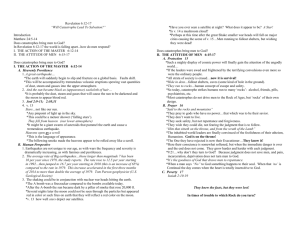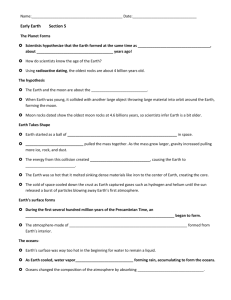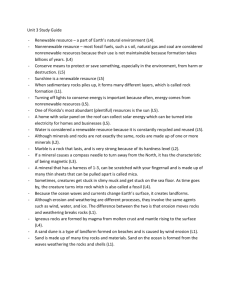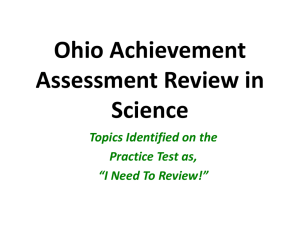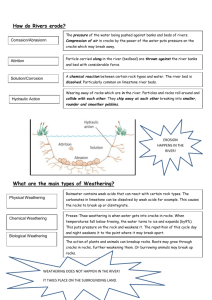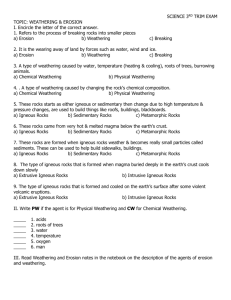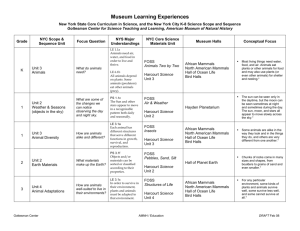Mr. Henkle CMT Review Sheet
advertisement
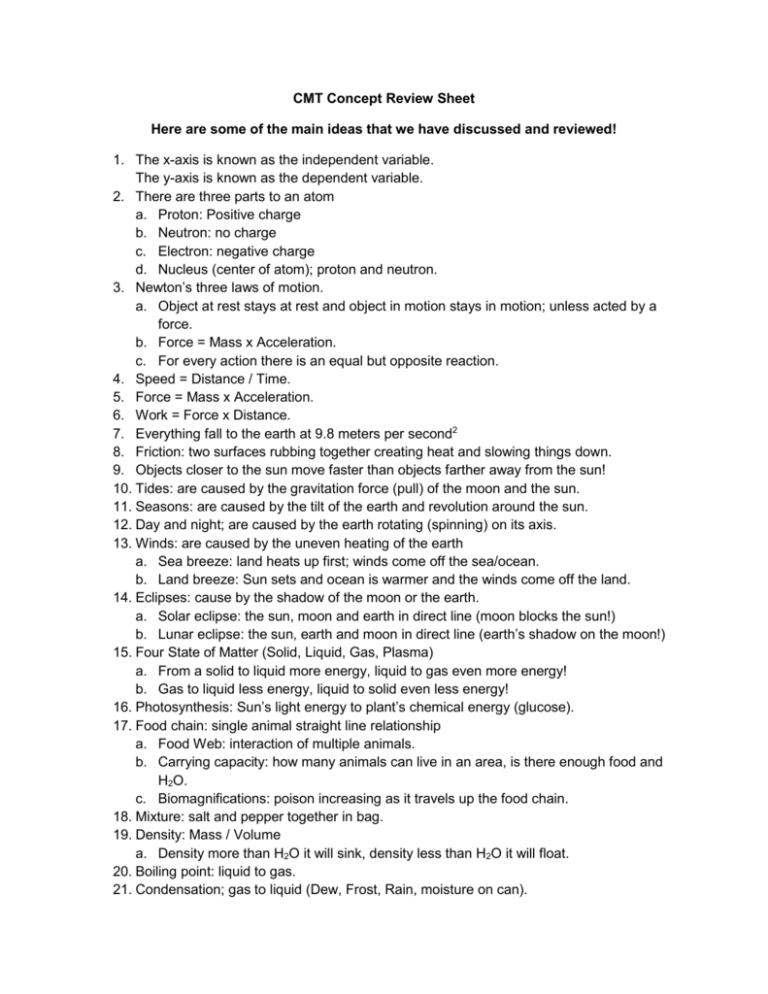
CMT Concept Review Sheet Here are some of the main ideas that we have discussed and reviewed! 1. The x-axis is known as the independent variable. The y-axis is known as the dependent variable. 2. There are three parts to an atom a. Proton: Positive charge b. Neutron: no charge c. Electron: negative charge d. Nucleus (center of atom); proton and neutron. 3. Newton’s three laws of motion. a. Object at rest stays at rest and object in motion stays in motion; unless acted by a force. b. Force = Mass x Acceleration. c. For every action there is an equal but opposite reaction. 4. Speed = Distance / Time. 5. Force = Mass x Acceleration. 6. Work = Force x Distance. 7. Everything fall to the earth at 9.8 meters per second2 8. Friction: two surfaces rubbing together creating heat and slowing things down. 9. Objects closer to the sun move faster than objects farther away from the sun! 10. Tides: are caused by the gravitation force (pull) of the moon and the sun. 11. Seasons: are caused by the tilt of the earth and revolution around the sun. 12. Day and night; are caused by the earth rotating (spinning) on its axis. 13. Winds: are caused by the uneven heating of the earth a. Sea breeze: land heats up first; winds come off the sea/ocean. b. Land breeze: Sun sets and ocean is warmer and the winds come off the land. 14. Eclipses: cause by the shadow of the moon or the earth. a. Solar eclipse: the sun, moon and earth in direct line (moon blocks the sun!) b. Lunar eclipse: the sun, earth and moon in direct line (earth’s shadow on the moon!) 15. Four State of Matter (Solid, Liquid, Gas, Plasma) a. From a solid to liquid more energy, liquid to gas even more energy! b. Gas to liquid less energy, liquid to solid even less energy! 16. Photosynthesis: Sun’s light energy to plant’s chemical energy (glucose). 17. Food chain: single animal straight line relationship a. Food Web: interaction of multiple animals. b. Carrying capacity: how many animals can live in an area, is there enough food and H2O. c. Biomagnifications: poison increasing as it travels up the food chain. 18. Mixture: salt and pepper together in bag. 19. Density: Mass / Volume a. Density more than H2O it will sink, density less than H2O it will float. 20. Boiling point: liquid to gas. 21. Condensation; gas to liquid (Dew, Frost, Rain, moisture on can). 22. Nor’easters (winter snow days): cold air meets with warm ocean water off the coast. 23. Simple machines: to make our life easier inclined plane, pulleys, levers, wedge, screw) a. Less work! 24. Kinetic energy: energy of motion (roller coaster, skier animation examples) 25. Potential energy: energy at rest (roller coaster, skier animation examples) 26. Weathering: Big rocks to small rocks a. Mechanical weathering: freezing/thawing H2O, roots and running H2O and glaciers. b. Chemical weathering: rocks are chemically changed carbonic acid! 27. Mountain rivers/streams create V-shaped valleys (fast moving H2O). Valleys are slow moving rivers called flood plains (New Orleans). 28. Plate Tectonics: a. Inner core: Solid iron/nickel b. Outer core: Liquid iron/nickel (spins creating magnetic field that protects earth from UV rays!) c. Mantel: hot liquid rock 29. Magma coming to the surface causes: a. Earthquakes, Volcanoes, mountain building. 30. Rocks: made of minerals a. Igneous: magma (intrusive: large crystals) or lava (extrusive: small crystals) b. Metamorphic rocks: (changed by heat and pressure) foliated (bands) or non-foliated c. Sedimentary rocks; made by pieces clastic or non-clastic d. Oldest rocks found on bottom, youngest on top! 31. Why does food spoil? Bacteria growth on food. a. Bacteria need H2O, a nice temperature, air. b. How do we stop bacteria growth? 1. Refrigerator/Freezer: to cold for growth. 2. Pasteurization: a little heat to kill most of the bacteria. 3. Dehydration: remove excess H2O. 4. Pickling: create a salt or acetic (acid) environment. 32. Mitosis: creating a duplicate cell that has the same DNA! 46 of the same chromosomes! 33. Meiosis: Creating sex-cells, a sex-cell only has 23 chromosomes a combination from mom and dad! 34. Digestive system (Nutrition): mouth, throat, stomach, intestines, gall bladder, liver, pancreas and the rectum. 35. Respiratory system (gas exchange O2 in CO2 out): mouth, throat, nose, lungs. 36. Circulatory system (Heart and blood) Heart is the pump that sends out fresh O2 blood into body and removes CO2 waste. Blood actually carries O2 in CO2 out. Blood cells are created in bone marrow. White blood cells fight off infections. 37. Excretory system: kidneys, bladder removes waste from body! 38. Reproductive systems: Male and Female reproductive system creates sex-cells.

